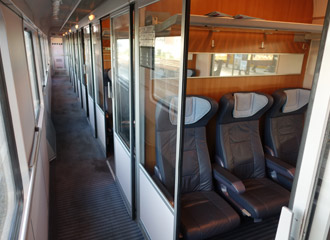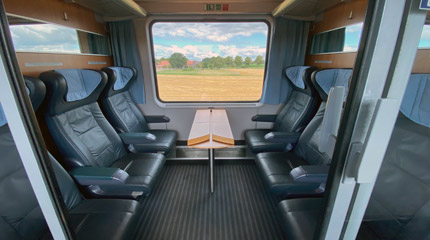 |
|
Buy Amsterdam-Berlin tickets from €37.99at int.bahn.de.Buy direct from Deutsche Bahn, no booking fee, print your own ticket or show it on your phone or laptop. |
Amsterdam to Berlin in 5h51
Comfortable air-conditioned InterCity trains link Amsterdam Centraal & Berlin Hbf every two hours, 624 km (399 miles) in 5h51 city centre to city centre from €37.99. A soulless flight will take the best part of 5 hours, cost more and be far less relaxing. Train is the way to go, look what you'll see on the way.
Journey time was cut from 6h23 in December 2023, by eliminating the locomotive change at Bad Bentheim and dropping several smaller stops in Germany.
A sleeper train also links Amsterdam & Berlin 3 times a week, see the European Sleeper page.
![]() What's the journey like?
Things to see...
What's the journey like?
Things to see...
![]() Amsterdam Centraal
station guide
Amsterdam Centraal
station guide
Train times eastbound until 14 December 2024
Train times eastbound from 15 December 2024
Train times westbound until 14 December 2024
Train times westbound from 15 December 2024
Notes for timetable
Travelling 7 June to 8 August 2025? Journey time is significantly extended due to trackwork. Departures from Berlin at 04:53, 06:55, 08:55, 12:55 & 14:55. Departures from Amsterdam at 08:00, 10:00, 12:00, 14:00 & 16:00.
These trains also call at Amersfoort, Deventer, Hengelo, Osnabrück, Hannover & several other stations. Check times at int.bahn.de.
* = Change trains at Hanover, arrive 22:01, depart 22:31.
European Sleeper = Sleeper train with sleeping-car & couchettes, see the European Sleeper train page. There'll be no Wednesday departure from Amsterdam & no Thursday departure from Berlin from 7 November 2023 to 24 March 2024, except for a few dates over Christmas & New Year, see the European Sleeper train page.
Amsterdam to Berlin is 642 km (399 miles) by train.
How much does it cost?
-
Advance-purchase fares start at €37.99 in 2nd class or €56.99 in 1st class.
These are Sparpreis (savings) advance-purchase fares with dynamic prices & limited availability at each price level. Only good for the specific departure you book, limited refunds, no changes to travel plans. A round trip is two one-ways. If you're happy to book ahead and commit to a specific train, this is what you want. Book early & avoid popular days for the cheapest prices.
-
The fully-flexible fare varies, but can be around €170 in 2nd class or €298 in 1st class.
The Flexpreis fare is what you pay if you want to stay flexible or buy a ticket at the station on the day. Flexpreis tickets are good for any train that day, unlimited availability, it can't sell out. The price may vary by date.
-
Children under 6 go free, no ticket required.
Children under 15 also go free when accompanied by an adult on a Sparpreis fare & added to the booking.
-
Fares for the sleeper train are shown on the European Sleeper train page.
How to buy tickets
-
Buy tickets from German Railways at int.bahn.de.
Booking opens up to 6 months ahead. Dates after the December timetable change usually open for booking mid-October. More about when booking opens.
Look for the direct Amsterdam-Berlin IC trains with 0 changes. It's around 12 minutes faster to change trains at Hannover onto a high-speed ICE, but I'd stick with a direct train, the time saving isn't worth the hassle of changing. Tip: Use the Direct services only toggle.
The system lets you choose your seat from a seat map.
I recommend registering when prompted, as you can then log in at any time to check or re-print your tickets.
If you buy one ticket covering several people, only one name is necessary to verify that the print-your-own ticket is yours.
You print your own ticket (A4 or U.S. Letter size paper is fine) or you can show it on your laptop or phone.
You can also buy tickets at Dutch Railways www.nsinternational.nl, but prices are the same & you can't choose your seat.
-
Seat reservation is optional for a small extra charge, €5.20 in 2nd class, €6.50 in 1st class, see the travel tips below. If you don't reserve a seat you can sit where you like, there are usually many empty unreserved seats, especially if you are boarding at the train's starting station rather than at an intermediate stop. However, these Amsterdam-Berlin trains can get busy in summer and at Christmas & Easter, so a reserved seat is a good idea. If you book at int.bahn.de you can select your exact seat from a seat map.
Update 2024: Seat reservation is compulsory on these cross-border ICs from 1 June to 1 September 2024.
-
In the unlikely event you have problems using bahn.de, you can also buy at www.raileurope.com & www.thetrainline.com at the same prices as they have a connection to DB's ticketing system.
-
Tip 1: If you don't see cheap fares between Amsterdam & Berlin it's worth splitting the booking, checking Amsterdam-Bad Bentheim and Bad Bentheim-Berlin which can sometimes make it cheaper! For example, when DB wanted €124 full-price for Amsterdam-Berlin, €49.99 tickets were available from Amsterdam to Bad Bentheim and €29.99 from Bad Bentheim to Berlin. But also tip 2 below.
-
Tip 2: If you don't see any cheap Amsterdam-Berlin fares at int.bahn.de, for example when booking at relatively short notice or on a busy day or date, here's a trick which can often reduce the cost. Go to Czech Railways www.cd.cz and book from Amsterdam to Prague (if you want Amsterdam to Berlin) or from Prague to Amsterdam (if you want Berlin to Amsterdam), first clicking More options then Travel via and entering Berlin as a via station. For example, on a busy Sunday afternoon booking only a week ahead, bahn.de had no Sparpreis fares available at all on one afternoon train from Berlin to Amsterdam and wanted €109 on another. Czech Railways had tickets available from Prague to Amsterdam for only €61 which included that first afternoon Berlin-Amsterdam train as part of the journey. Buy, print out your ticket and travel! It is perfectly legitimate to use only the Berlin-Amsterdam part of a Prague-Amsterdam ticket and there are no problems doing this - German conductors are able to scan Czech ticket barcodes. Works some times, doesn't work all the time, but worth trying!
-
Buy tickets for the sleeper train as shown on the European Sleeper train page
Route map
Click for larger map. Red = high-speed lines. Green = scenic sections of line. Black = conventional lines.
Reproduced from the European Rail Map with kind permission of the European Rail Timetable people. I recommend buying a copy of the European Rail Map for your travels, www.europeanrailtimetable.eu with shipping worldwide.
What's the train like?
Current Intercity (IC) trains are composed of first-generation Intercity cars, spacious, smooth-riding and comfortable. There is now no bistro car, as these were withdrawn from all German Intercity trains and replaced by a refreshment trolley in December 2023, pending arrival of new trains.
New ICE-L trains will enter service by the end of 2024: New ICE-L trains are being built by Spanish company Talgo and will start to replace these classic IC1 trains from late 2024. The L stands for Low-Floor as these trains are composed of a locomotive pulling or pushing little articulated low-floor carriages designed for easy level boarding. Each car is half the length of a conventional ICE car and articulated to its neighbour with just two wheels under each articulation, rather than a conventional 4-wheel bogie. They will have 1ast & 2nd class, power sockets, WiFi, a restaurant car and 8 bike spaces.
An Amsterdam to Berlin Intercity train, at Amsterdam Centraal. Watch the video.
2nd class seating is usually in open-plan saloons like this, most seats unidirectional, but with some tables for 4. Larger photo.
There is usually one 1st class car with seats in traditional 6-seat compartments with side corridor, plus a few 1st class seats in part of the bistro car. Larger photo. Larger photo.
What's the journey like?
Amsterdam. The historic Amsterdam Centraal station opened in 1889, right in the city centre, a stroll from most hotels. For a coffee, beer or meal before boarding the train to Berlin, try the beautifully retro Grand Cafe 1e Klas on platform 2B - look for the cockatoo on the bar. See Amsterdam Centraal station guide.
Deventer & River IJssel. As you cross the River IJssel at Deventer you'll see a film star. The white arched steel road bridge across the IJssel at Deventer just upstream from the rail bridge played the part of the famous John Frost Bridge at Arnhem in the 1976 film A Bridge Too Far. You can see it in the distance in the photo above which was taken from the train. Eastbound from Amsterdam, it's on the right hand side 2 minutes before arriving at Deventer station. Westbound from Berlin it's on the left hand side 2 minutes after leaving Deventer station.
You'll see how built-up the western part of the Netherlands is, but once in the east of the country you'll see plenty of farmland, cattle and ancient Dutch farms. Watch for the subtle differences between Dutch and German houses...
Kaiser Wilhelm Monument (above left). You pass the Kaiser Wilhelm monument on the left between Bad Oeynhausen & Minden when heading to Berlin, on the right when heading to Amsterdam. Erected in 1892-96 it's one of Germany's national monuments.
Minden (above right). The train passes the fortress-like Minden station built in 1848.
Osnabruck (above left)... Change here for trains to Hamburg & Scandinavia, see the illustrated guide to changing trains at Osnabruck.
Hannover (above right). A major stop with 14 busy modernised platforms. Change here for Intercity trains to Leipzig & Dresden, and regional trains to the Harz region.
Wolfsburg & the original Volkswagen factory. The train passes Wolfsburg, Volkswagen's worldwide headquarters. You'll see Volkswagen's original factory built in 1938 right next to the station on the left when heading to Berlin, on the right when heading to Amsterdam. The factory produced thousands of VW Beetles, as well as kubelwagens during the war.
After swishing across the Netherlands and western Germany at up to 140km/h (87 mph) the train eventually joins the new high-speed line between Hanover and Berlin and accelerates up to 200km/h (125 mph).
Berlin. Berlin's glass-and-steel Hauptbahnhof opened in 2006, a total contrast to Amsterdam, Centraal. Just 17 minutes walk past the Reichstag building to the Brandenburg Gate. See Berlin Hbf station guide.
Travel tips
-
1st or 2nd class?
2nd class is absolutely fine for most travellers, there's no need to go 1st class unless you don't mind the extra cost. The photo below shows the generous legroom for 6-footers even in 2nd class. But check prices at int.bahn.de because 1st class doesn't always cost much more. 1st class simply means more leg and elbow room and usually a quieter environment.
-
Luggage
You can pretty much take anything you like as long as you can carry it or pull it behind you. Nobody weighs or measures it! You take it with you onto the train, there's plenty of luggage space in both classes, the racks above your seat take anything up to backpack-size, the racks at the end of the car will take large suitcases, see the photo below. More about luggage on European trains.
-
Seat reservations
A seat reservation is optional on this route. If you choose not to make one, you can sit in any unreserved seat - a small electronic display above each seat shows whether it is reserved or not. However, a seat reservation is a good idea especially on busy Fridays or around holiday periods. You can add a seat reservation to your booking when you buy your ticket for around €4 in 2nd class, free in 1st class. It's not possible to specify an exact seat or a seat facing direction of travel on these trains, but on int.bahn.de you can request a window or aisle seat, or a seat with a table (Tisch in German), which means face-to-face seats at a fixed wooden table. All seats in fact have small drop-down tables.
-
Saloon or compartment?
If you choose to reserve, the site asks if you prefer an open-plan saloon or a seat in a traditional 6-seater-compartment. On these Berlin-Amsterdam trains there's one or two 1st class cars with 6-seat compartments. In 2nd class, almost all seating is in open-plan saloons which is probably the best choice, but in one coach there are a few 6-seater compartments which you might like if you are a small group or family of 5-6 persons. On your ticket it will say Abteil for compartment, or Grossraumwagen for open-plan car.
-
Seat maps
Click here for a generic seat plan for a German intercity train. The 1st class car is usually a type Avmz, and 2nd class cars are type Bpmz or Bpmbz with one car usually being a Bvmsz.
-
First class lounges in Amsterdam & Berlin
At Amsterdam Centraal, all 1st class passengers can use the NS International lounge with complimentary tea, coffee, juice, see here for details.
At Berlin Hbf, the DB first class lounge can only be used with the most expensive 1st class Flexpreis fares, not with a 1st class railpass or an advance-purchase Sparpreis or Super Sparpreis fare.
-
Best place to wait for your train Amsterdam
I recommend the beautifully retro Grand Cafe 1e Klas on platform 2B for a beer, coffee or meal before your train. Give my regards to the cockatoo on the bar...
-
Boarding your train
As with virtually all European trains, there's no check-in. Just stroll into the station, find your train and get on, any time before it leaves. The doors may be closed a minute before departure. At Berlin Hbf, trains to Amsterdam use the east-west platforms above ground level, as opposed to the north-south lines below ground.
Tip: You can see what the train formation is like at www.vagonweb.cz, which might help you find your car. Change cs to en upper left, then click Train formations, scroll down to Germany and click IC. Select your specific train. Click the camera icon under each car for photos, click the seat map icon for a seat map (if available).
Posters on the platform and/or a diagram on the platform departure screens show the train formation with letters indicating where to stand along the platform for your particular car number, to save you running up and down when it comes in. The 1st class car is normally at the rear of the train when heading east towards Berlin and at the front behind the locomotive when heading west towards Amsterdam.
-
On the reservation displays above each seat
Small LED displays above each seat show which seats are reserved between which stations, and which seats are free. You may see these messages:
ggf. freigeben - this is a last-minute reservation seat. You can sit in it if you like, but will have to move if someone shows up with a reservation. Find another seat if you can.
ggf. reserviert - this means the train's on-board reservation system hasn't been updated with the latest information from the main DB reservation system. Usually all of the seats show this message if this happens. Seat reservations are still valid, but cannot be shown on the LED displays, so you can sit in these seats but you could be asked to move if someone shows up with a reservation.
bahn.comfort - travellers holding a frequent traveller BahnCard have priority for these seats. You can sit in these seats but someone with a BahnCard may show up and claim it. Though how they'd know you didn't have a BahnCard and so ask you to move is another question! Find another seat if you can.
Schwerbehinderte means that seat is reserved for people with disabilities.
-
Power sockets, WiFi & toilets
There are power sockets at all seats in both classes. Each car has at least one toilet. These trains are being fitted with WiFi, and there's good mobile data reception along most of the route.
-
Bicycles
Bicycles can be taken on these trains, bike spaces must be booked in advance, you can add a bike to your booking at int.bahn.de. The bicycle compartment is in the 2nd class car at the opposite end of the train from the 1st class cars, in other words at the front when heading east towards Berlin, at the rear when heading west towards Amsterdam.
Food & drink on board
The bistro car is replaced by a refreshment trolley from December 2023 until the new ICE-L trains arrive at some point during 2024 or 2025. The new trains will have a bistro. You are free to bring your own food, even wine or beer if you like.




















